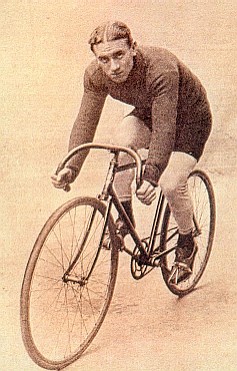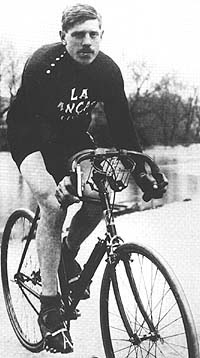 |
| Phillipe Thys |
The weather was very hot during the race and after only four stages 65 of the 113 racers had already quit. Many of the French favorites abandoned the race early. Eugene Christophe in the 7th stage, Jean Alavoine in the 2nd stage, Francis Pelissier in the 3rd stage and Henri Pelissier after the 5th stage.
Henri Pelissier won the 3rd and 4th stages of the 1920 Tour de France. Pelissier was Philippe Thys's, who was leading the race, biggest threat at this part of the race. During the 5th stage Henri Pelissier was penalised two minutes for illegally throwing away a flat tire. Racers were required at this time to finish the stages with everything that they had started the stages with. Pelissier objected to the penalty and quit the race. Desgrange was critical of Henri Pelissier in the newspaper L'Auto. He said that Henri Pelissier wasn't tough enough and would never win the Tour de France. Three years later in 1923 Henri Pelissier did win the Tour de France. Click here for more on Henri Pelissier.
Philippe Thys rode a smart race and conserved his energy during stages 6 and 7, which were in the Pyrenees mountains. He stayed within range of any rider who might be a threat to his lead. But did not try to break away from them.
Philippe Thys rode a smart race and conserved his energy during stages 6 and 7, which were in the Pyrenees mountains. He stayed within range of any rider who might be a threat to his lead. But did not try to break away from them.
Firmin Lambot, on the left in the above photo, took over 15 hours to complete stage 6. Jules Masseli, on the right, would finish in 18 hours and 35 minutes. Masseli finished in the middle of the field at the end of stage 6. In this photo the two riders are on the climb of the Toumalet.
Philippe Thys increased his lead to exactly an hour during stage 9 over second place rider Hector Heusghem. He won the stage with some tough climbing on the way to the finish in Nice. The tour organizers were late awarding the Maillot Juane (yellow leader's jersey). It was awarded to Philippe Thys after his stage 9 victory for the first time during the 1920 Tour de France.
Honore Barthelemy
Honorey Barthelemy had an epic ride during stage 9 of the 1920 Tour de France. It all started when he hurt his back so badly in a crash that he had to turn his handlebars up so he didn't have to bend over to reach them. Also during that crash a road flint pierced and ruined one of his eyes. He removed the flint and got back on his bike to finish the stage bleeding, beat up and half blind. In later falls he added a broken wrist and a dislocated shoulder to his list of injuries during the 1920 tour. Honorey Barthelemy continued on, despite his injuries, and finished the 1920 Tour de France in eighth place. He was the top placed French rider during that year's Tour de France. He later replaced the eye with a glass one that he frequently lost during races. At the final finish line, of the tour, the fans carried Barthelemy across the line. Click here for more on Honorey Barthelemy.
Noel Amenc walks up the Pyrenean stage to Luchon during the 1920 Tour de France.
The 1920 Tour de France ended at the Parc de Princes velodrome in Paris. There were an estimated 20,000 cycling fans on had for the finish. The crowds were so large racers had to walk their bikes across the finish line.
The race was dominated by Belgians. The Belgians won 12 of the 15 stages and the overall victory.
Philippe Thys's 1920 Tour de France victory was his third victory in that race. He was the first racer ever to win the Tour de France three times. It is speculated that he could have won the race as many as 6 or 7 times if his racing career hadn't been interrupted mid stream by World War I.
There were 22 finishers of the 1920 Tour de France. Below are the top five places in the overall general classification:
- 1. Philippe Thys: 228 hours 36 minutes 13 seconds
- 2. Hector Heusghem @ 57 minutes 21 seconds
- 3. Firmin Lambot @ 1 hour 39 minutes 35 seconds
- 4. Leon Scieur @ 1 hour 44 minutes 58 seconds
- 5. Emile Masson, Sr. @ 2 hours 56 minutes 52 seconds
 |
| Philippe Thys, winner of the 1920 Tour de France Click here for more on Philippe Thys. |
 |
| Hector Heusghem, second place in the 1920 Tour de France. Click here for more on Hector Heusghem. |
 |
| Firmin Lambot, third place in the 1920 Tour de France. Click here for more on Firmin Lambot. |
 |
| Leon Scieur, fourth in the 1920 Tour de France. Click here for more on Leon Scieur. |
 |
| Emile Masson, Sr., fifth place in the 1920 Tour de France. Click here for more on Emile Masson, Sr. |





No comments:
Post a Comment